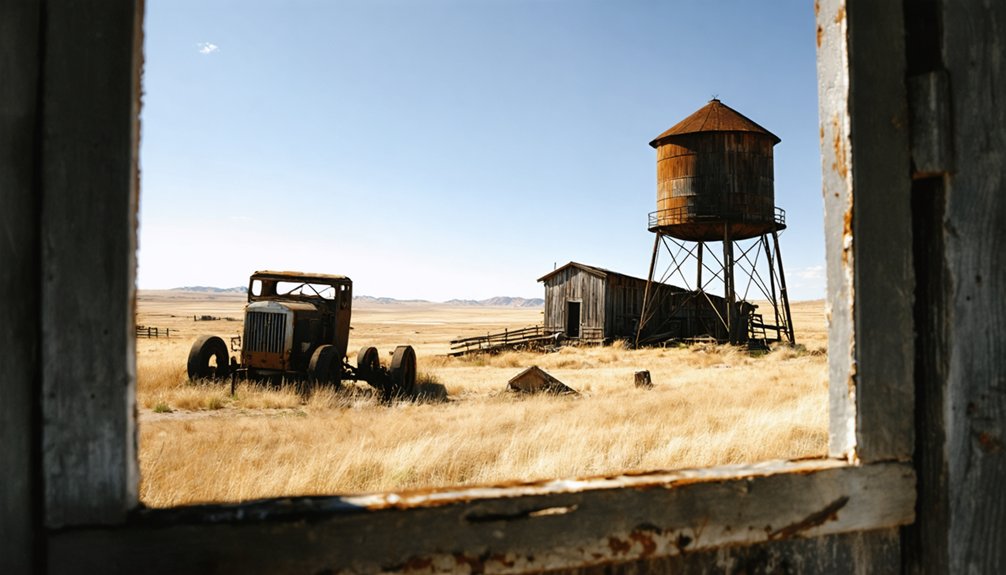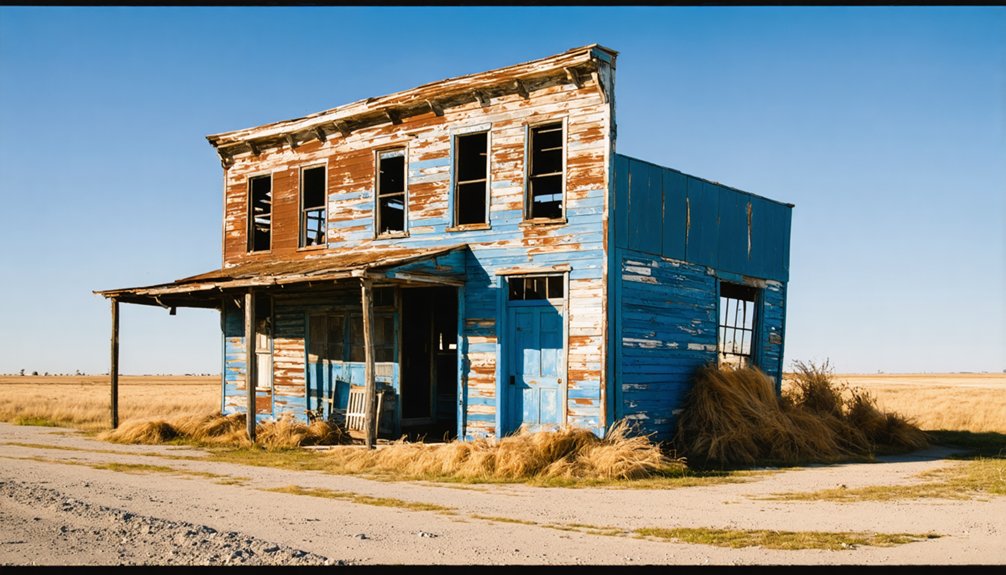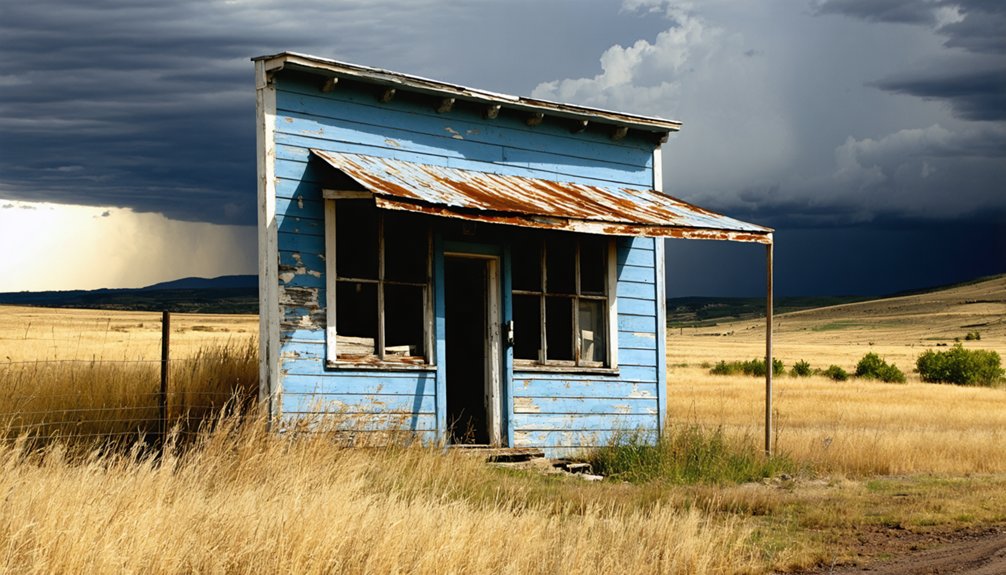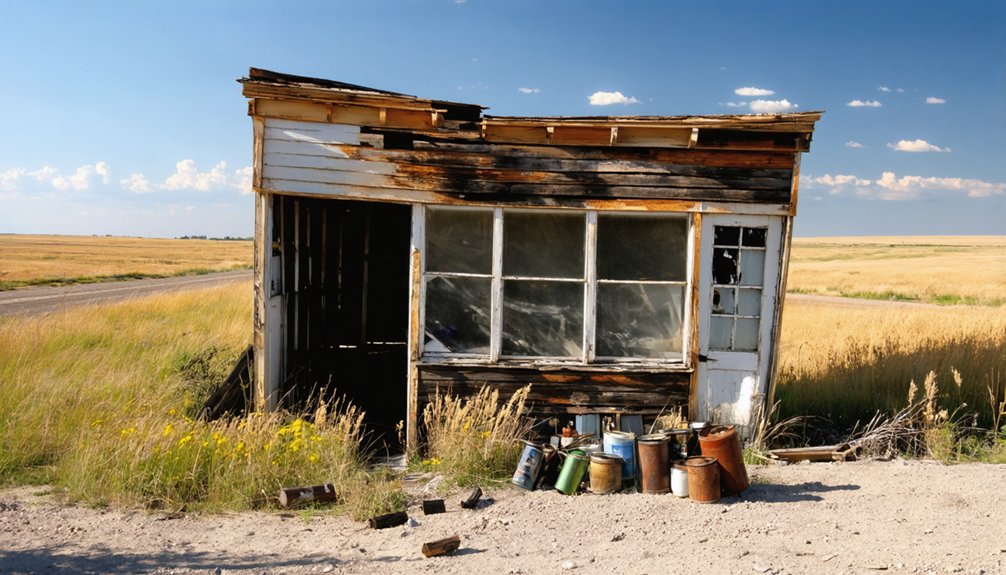You’ll find Montana City among South Dakota’s Black Hills, where gold’s discovery in 1874 sparked a mining rush. The settlement boomed after Fred and Moses Manuel’s Homestake claim in 1876, with George Hearst’s purchase transforming it into an industrial mining operation. Though once bustling with miners, saloons, and commerce, the town declined in the 1930s as gold deposits dwindled. Today, the abandoned site offers scattered artifacts and raw terrain that tell a compelling frontier story.
Key Takeaways
- Montana City emerged during the 1870s Black Hills Gold Rush after Custer’s expedition discovered gold in the region.
- The town’s economy centered around mining activities, supported by essential water resources from nearby streams.
- Daily life featured a mix of tents, wooden buildings, and mining culture, with saloons serving as social hubs.
- Economic decline began in the 1930s due to mineral depletion and discontinued railroad service.
- The site is now completely abandoned with no standing structures, though scattered artifacts provide insight into frontier life.
The Rise of a Black Hills Mining Settlement
When General George Custer’s 1874 expedition discovered gold in the Black Hills, it sparked a transformative period in the region’s history.
You’d have seen prospectors quickly spreading from French Creek near Custer to Whitewood Creek near Deadwood by 1875, initially focusing on placer gold in creek beds.
The real cultural shifts began after Fred and Moses Manuel discovered the Homestake claim on April 9, 1876. This discovery revolutionized the area’s mining approach, bringing forth significant mining innovations as operations evolved from individual prospecting to industrial-scale extraction.
The Homestake claim discovery marked mining’s evolution from lone prospectors to industrial giants, reshaping the Black Hills forever.
You’ll find that George Hearst’s $70,000 purchase of the Homestake Mine in 1877 marked a pivotal moment, introducing mechanized mining and advanced processing methods.
The region transformed rapidly from frontier wilderness into bustling mining communities, forever changing the Black Hills’ landscape and social fabric. The area’s rich mineral deposits included mica and beryllium from extensive pegmatite formations.
The Homestake Mine became one of the world’s most productive gold sources, generating an astounding 10% of global gold during its 125-year operation.
Life in a Frontier Boomtown
As frontier boomtowns sprang up across the American West, you’d have found a chaotic mix of tents, wooden shacks, and hastily constructed buildings housing the surge of fortune-seekers.
The mining culture revolved around backbreaking work in dangerous conditions, while saloons and gambling halls served as the heart of social life after dark. You’d have witnessed frequent disputes over mining claims and experienced the harsh realities of inadequate sanitation and overcrowding. The arrival of the Northern Pacific Railroad transformed many of these makeshift settlements into thriving communities.
Community challenges included establishing basic law and order in a place where vigilante justice often prevailed. Though merchants and civic leaders worked to create stability through schools and churches, the town’s character remained rough and transient. The establishment of Virginia City’s first newspaper helped bring a sense of civilization to the wild frontier.
Workers from diverse backgrounds formed tight-knit social networks, even as they faced the boom-and-bust cycle of frontier resource extraction.
Geographic Features and Natural Surroundings
You’ll find Montana City nestled within the rugged Black Hills terrain, characterized by its ponderosa pine forests and granite formations that made mining operations both challenging and promising.
Like many ghost town sites, the area has gradually reverted to its natural state over time. The town’s location provided access to essential water resources through nearby streams, which prospectors used for both survival and mining operations.
The surrounding mountainous landscape created natural routes that miners used to transport equipment and ore, though these paths were often treacherous during harsh weather conditions. Similar to towns like Pactola and Sheridan, Montana City’s original landscape was drastically transformed by extensive mining activity.
Black Hills Terrain Features
Rising dramatically from the surrounding Great Plains, the Black Hills form an impressive dome-shaped mountain mass stretching 110 miles long and 70 miles wide into Wyoming.
You’ll find these ancient formations towering 3,000 to 4,000 feet above the plains, reaching their pinnacle at Black Elk Peak – the highest point east of the Rockies at 7,242 feet.
The Black Hills geology showcases a distinctive Red Valley, known as the Race Track, which encircles the hills with its Dakota Sandstone hogback ridge. This unique landscape resulted from an uplift 65-70 million years ago during the late Cretaceous period.
Within the central region, the Black Hills ecology thrives in wide valleys called “parks,” featuring deep river-cut gorges and dramatic rock formations.
Dense ponderosa pine forests dominate the northern section, while the southern hills blend mixed-grass prairies with scattered pines, creating the dark silhouette that inspired the region’s name. The area’s dry atmosphere makes exploring these diverse landscapes more comfortable even during peak summer temperatures.
Mining Access Routes
The rugged terrain of the Black Hills shaped the development of mining access routes to Montana City, a lesser-known camp situated near the bustling hubs of Deadwood and Lead.
You’ll find that miners relied on primitive dirt tracks and natural pathways following gulches and creek beds to reach their claims. These mining trails often proved treacherous, especially during winter snows and spring thaws. Similar to hard rock mining techniques used in Montana’s Garnet ghost town, the challenging landscape required innovative approaches to accessing mineral deposits. Like the Montana Southern Railroad that once served Coolage, reliable transportation was crucial for mining operations.
Access challenges were constant, as the camp never developed sophisticated infrastructure like railroads or bridges. Instead, you’d have encountered a network of basic wagon roads connecting to regional stagecoach routes that linked Montana City with larger supply centers.
Today, these historical pathways have largely disappeared, reclaimed by the dense forests and steep hillsides of the Black Hills, making the ghost town’s original routes difficult to trace.
Regional Water Resources
While Montana City’s survival depended heavily on mining, its water resources proved equally vital to the settlement’s existence.
You’ll find the Yellowstone River served as the primary water source, flowing at an average of 12,834 cubic feet per second, with peaks during spring snowmelt. Water availability fluctuated seasonally, impacting both surface and groundwater resources.
The region’s complex aquifer system, including the Madison and Minnelusa formations, provided essential groundwater supplies.
These sensitive water sources required careful protection from groundwater contamination, especially in areas where surface water connected with aquifers.
Montana-Dakota Utilities addressed these concerns by establishing protective measures, including a non-discharging clay-lined sewage lagoon downstream from their water intake, ensuring safe drinking water for the settlement’s residents.
Economic Activities and Industry

You’ll find that Montana City’s primary economic driver was gold mining, which began with simple placer mining operations and evolved into more organized hard rock extraction methods during the mid-to-late 19th century.
Local sawmills supported the mining industry by providing essential timber for mine shaft supports and building construction, while also generating heating fuel for the community.
The town’s commercial district featured typical frontier businesses including general stores, blacksmith shops, and saloons that served the mining population until the eventual depletion of gold deposits led to the town’s decline.
Mining Operations and Gold
Mining operations in Montana City began during the Black Hills Gold Rush of 1874-1876, sparked by Colonel Custer’s expedition’s gold discoveries.
You’d have found early prospectors working placer mining claims, using labor-intensive techniques like panning and sluicing to separate gold from stream sediments. As surface deposits dwindled, operations shifted to hard rock extraction, targeting gold embedded in quartz veins within the region’s geological formations.
The area’s mining innovations included advanced crushing machinery and chemical processing methods, particularly for handling complex refractory ores.
While the nearby Homestake Mine flourished, producing 10% of the world’s gold supply, Montana City’s role as a mining hub gradually diminished.
The town’s eventual abandonment reflected the broader pattern of ghost town dynamics, where settlements rose and fell with the exhaustion of viable deposits.
Sawmill Industry Impact
The rapid expansion of Montana City brought not just gold seekers but also a thriving sawmill industry that shaped the region’s economic landscape.
You’ll find that sawmill innovation took off quickly, with the first operation established by John Frances Murphy in nearby Custer City in February 1876.
As settlements grew, the timber trade became essential for building homes, businesses, and mining infrastructure.
Local Trade and Commerce
While gold and silver strikes initially drew settlers to Montana City, diverse economic activities soon transformed the settlement into a bustling commercial hub.
The trade dynamics shifted dramatically as railroads connected the town to larger markets, enabling merchants to establish thriving businesses that served both miners and farming families.
You’ll find that commerce evolution followed a distinctive pattern typical of frontier towns:
- Early trade focused on mining supplies, with stores and blacksmiths supporting prospectors.
- Agricultural commerce emerged as farmers settled nearby, leading to grain storage facilities.
- Service industries developed, including hotels, cafes, and entertainment venues.
When rail lines bypassed Montana City, you’d have witnessed how quickly trade patterns changed, redirecting economic activity to better-connected towns and ultimately contributing to Montana City’s decline.
Notable Buildings and Landmarks

Remnants of Montana City’s rich mining heritage can be seen through its diverse collection of historic structures and landmarks.
You’ll find stamp mills and assay offices that once processed precious metals, alongside essential mining infrastructure like shaft entrances and equipment buildings.
As you explore the town’s commercial district, you’ll discover wooden storefronts that housed general stores and saloons with their distinctive Western false fronts.
Churches stand among the best-preserved historic structures, while miners’ cabins and family homes dot the landscape near former mining sites.
Sacred spaces and humble dwellings endure as testament to the faith and fortitude of Montana City’s mining community.
The cemetery serves as a poignant reminder of the town’s earliest settlers.
Through self-guided tours, you can visit these landmarks while interpretive signs help you understand their historical significance.
Many building foundations and cellar holes remain visible, offering glimpses into Montana City’s original layout.
The Town’s Decline and Abandonment
During the late 1930s, Montana City began its descent into abandonment as gold and mineral resources steadily depleted throughout the region. The town’s economic vulnerability became apparent as mining operations ceased, triggering mass job losses and population decline. Without economic diversification, Montana City couldn’t sustain itself.
The town’s demise accelerated due to three crucial factors:
- Railroad service discontinuation severed essential transportation links for supplies and exports.
- Young working-age residents departed for urban centers, leaving an aging population behind.
- Closure of necessary services like schools and businesses eliminated community infrastructure.
As remaining residents faced increasing hardship without basic services, Montana City gradually transformed from a bustling mining town to a ghost town. The harsh weather and geographic isolation further complicated recovery efforts, ultimately sealing the town’s fate.
Preserving Montana City’s Legacy

As Montana City’s historic structures face ongoing threats from weather and neglect, preservation efforts have emerged through various state and federal programs to protect the town’s cultural legacy.
You’ll find heritage conservation initiatives focused on maintaining the site’s authentic character while preventing further deterioration of remaining buildings.
Through the National Register listing, property owners can access Federal Historic Preservation Tax Credits for rehabilitation projects.
The state’s Certified Local Government program has fostered community engagement by providing preservation funds and technical assistance.
You’ll discover that repair work strictly follows the National Park Service’s standards, ensuring original materials and designs are preserved whenever possible.
Local historical societies have also installed markers to commemorate the site’s significance, making Montana City’s story accessible to visitors while promoting heritage tourism.
Historical Significance in South Dakota
Montana City’s emergence in spring 1876 marked a pivotal moment in South Dakota’s territorial expansion, establishing one of the earliest mining settlements during the Black Hills Gold Rush.
You’ll find its cultural heritage deeply intertwined with the transformation of the region from Native American lands to a mining frontier, reflecting the complex relationships between settlers and the Sioux nation.
The settlement’s economic impact resonated throughout Lawrence County, contributing to:
- Development of essential transportation networks and telegraph lines connecting the Black Hills to eastern regions
- Establishment of mining infrastructure that shaped future town developments across South Dakota
- Creation of supply chains and trade routes that supported the region’s rapid growth during the Dakota Boom
The town’s story exemplifies the spirit of freedom and opportunity that drew settlers westward, despite the controversial displacement of Native peoples.
What Remains Today: A Ghost Town’s Story
Today, when you visit the former site of Montana City, you’ll find little more than subtle traces of its mining-era past. The landscape has largely reverted to natural pasture, with foundations and ground depressions offering the only hints of the bustling town that once stood here.
For urban exploration enthusiasts and ghost town photography buffs, the site presents a unique challenge – capturing the essence of absence rather than presence.
Unlike some preserved ghost towns in South Dakota, Montana City stands as a stark example of complete abandonment. You won’t find standing structures or interpretive markers here.
Instead, the site’s significance lies in what time has erased – a powerful reminder of the boom-and-bust cycle that shaped the Black Hills region. The scattered artifacts and landscape features tell a silent story of frontier dreams and eventual desertion.
Frequently Asked Questions
Were Any Notable Crimes or Murders Recorded in Montana City’s History?
You won’t find documented murders or notable crimes in historical accounts from this location – while unsolved mysteries might exist, no verified criminal incidents appear in surviving research materials.
What Happened to the Residents’ Possessions When They Abandoned the Town?
You’ll find that residents likely left many abandoned belongings behind, though there’s no specific documentation. Time, weather, and scavengers have claimed most potential historical artifacts from this period.
Did Any Famous Personalities or Historical Figures Visit Montana City?
Despite thousands passing through the Black Hills region, you won’t find records of famous visitors to this particular settlement. Historical significance remains limited to its brief role as a mining outpost.
Were There Any Documented Paranormal Activities or Ghost Stories?
You won’t find documented ghost sightings or haunted locations from Montana City’s history. Unlike other Black Hills ghost towns, there aren’t any verified paranormal accounts or historically recorded supernatural events here.
How Did Postal Services and Communication Systems Operate in Montana City?
Like pioneers blazing trails, you’d find postal routes through nearby settlements and railroads, while communication methods relied on stagecoach deliveries, telegraph lines, and informal hubs like saloons and bulletin boards.
References
- https://en.wikipedia.org/wiki/List_of_ghost_towns_in_South_Dakota
- https://www.sdpb.org/rural-life-and-history/2023-08-21/some-black-hills-ghost-towns-and-their-origins
- https://www.sdhspress.com/journal/south-dakota-history-2-2/some-black-hills-ghost-towns-and-their-origins/vol-02-no-2-some-black-hills-ghost-towns-and-their-origins.pdf
- https://www.geotab.com/ghost-towns/
- https://www.youtube.com/watch?v=_0WNYsFLSLA
- https://avrextravel.com/montana-ghost-towns/
- https://www.1880town.com
- https://en.wikipedia.org/wiki/Mondak
- https://history.sd.gov/museum/docs/LifeUnderground.pdf
- https://en.wikipedia.org/wiki/Black_Hills_gold_rush



